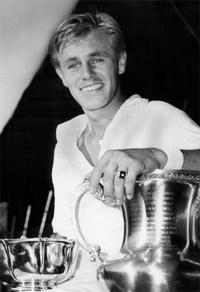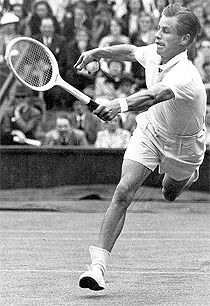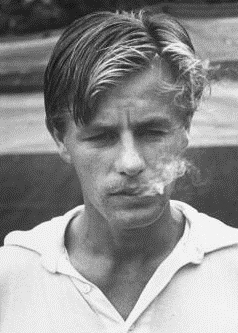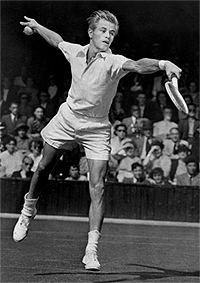Art "Tappy" Larsen:
Fascinating
Gardnar Mulloy

From the time I met him, I was fascinated by Art Larsen. I first played him - an unknown American "hope" from San Francisco--in an early round of an eastern grass court tournament. I gave him a very bad beating.
In the dressing room after the match he had disgustedly packed his bags and announced he was going home. "I'm going to return my expense money to the Association," he declared, 'I'll never make a tennis player."
"Hold on kid," I said. "That's no way to talk. All right, so you've had a beating. But you played very well."
"Like hell I did," he groaned.
"Sure you did," I said. "Very well for your first game on grass."
"Yeah, I know," Art said. "But the guys back West aren't here to listen to you."
"So you think you've let down your Association," I countered. "Nuts!" I replied. "The officials don't expect you to return waving a flag full of battle honors on your first tour playing the big tournaments."
"C'mon snap out of it. In a year or two you'll be a great player," I concluded My calculated mix of flattery and argument work and revived his confidence and he remained in the East to play out his tour.

When I next encountered Art, in the 1949 final of the Easter Championships, his inherent greatness was emerging. A lefty, he was athletic and gifted with great variety of shot and natural feel.
The next year he would win the U.S. Nationals (now the U.S. Open) and be ranked number 3 in the world. Although that was his only Slam title, he remained an elite player who went on to make another U.S. final, a French final, an Australian semifinal, and 3 quarterfinals at Wimbledon.
In our second match, Art won the first two sets and it looked certain he would beat me and would win the championship. But in this match I noticed something strange. I noticed that when we passed changing ends he would deliberately tap me, sometimes going out of his way to do so. It finally occurred to me that this was his good luck ritual.
The Fetish of Fortune
Seeing no reason why I should be his fetish of fortune, I avoided him and started crossing over at the opposite end of the net from Larsen. His tennis went to pieces.
He spent the rest of the match trying to get near enough to tap me. He never did. Dodging him at every turn, I won the next three sets in a row to become the Eastern Champion.
As his success and fame grew, Art's tapping also became legendary. He became known "Tappy" Larsen and was widely called by that nickname.

Wherever he went, on court or off, continually and systematically he tapped, tapped with his racquet, his hand, his feet, even his head, shoulders and hips. In the dressing room he tapped his shoes, his racquet, his locker, every damn thing in sight.
Once I had to disentangle him from a wire coat hanger he had put on with his shirt! The mania was itself crazy enough. But Art performed it according to a system, with different sequences of tapping.
In his own words, he had "onesy" or "twosy" or "threesy" days. Relative to which day he felt it to be he would tap things once, twice or three times. There was no stopping the guy.
Start of the Tap
It all began during his time in the army in World War II when he was slogging it out against General von Runstedt's brutal winter offensive of 1944-45 on the French border. In the forests of the Ardennes, where sudden death waited behind every other tree, his fears kindled some primeval, pagan urge and ritualistic appeal to a "goddess of luck."

He began to tap the trees. And as he escaped what seemed like certain death, he came to believe that his tapping was the reason, a communion between him and his goddess protected his life. Coming through the battle unhurt, he swore for the rest of his life it was the "tree tapping" that protected him.
But even if he had never tapped a thing, Art Larsen would still be one of the most colorful characters in the history of our sport, or any sport. In dressing rooms all over the world, players heard his conversations with the imaginary eagle perched on his shoulder.
On court umpires and opponents can testify to his ability to maintain a running argument with the eagle while making "impossible" shots at the same time. Every game to him in was a tremendous emotional experience.
Not everybody understood this, so he suffered frequently from attacks by the press. Like Billy Talbert, Larsen loved the social round, parties, dancing, drinking, smoking, and staying up late.
He sang tolerably well and never declined an invitation to step up to the microphone to warble a few bars. A speech by him at a stuffy banquet was usually something to be remembered, a shocked audience hardly believing it ears as they listened to an outrageously dirty story told in the most unashamed and totally inoffensive manner.
He loved women. There were always several in his life. Art never entangled with just one when he could do so with three or four. Yet, because he treated them all so well, no matter who they were, they seemed to adore him.
The Accident

Yes, Art Larsen loved life and life loved Art until 1956. Then his "good luck goddess" deserted him. While riding his motor scooter he was involved in an accident which severed an artery in his brain.
For two weeks he lay unconscious in a hospital, not expected by the doctors to live. But miraculously he recovered. Tragically there were enfeebling after effects.
For the rest of his life he was partially paralyzed on his right side, blind in his left eye and had an impediment in his speech. He had to learn to write again. He could not play, but traveled the tennis circuit vowing that one day he would chase titles again.
In the winter of 1956 Gladys Heldman, publisher of World Tennis Magazine, together with Don Budge and Dick Savitt, proposed an exhibition in New York to raise funds to assist Art in his rehabilitation.
Players from all over the country turned up at the 7th Regiment Armory in New York to play, or act as ticket collectors and ushers. The place was packed with spectators, thousands being turned away at the gates.
Twenty-two thousand dollars were raised. If there had ever been doubts about Art's popularity that night dispelled them. Although it never happened, if there was one thing I always hoped to see on a tournament tennis court one more time, it was Arthur Larsen of San Leandro, California.



